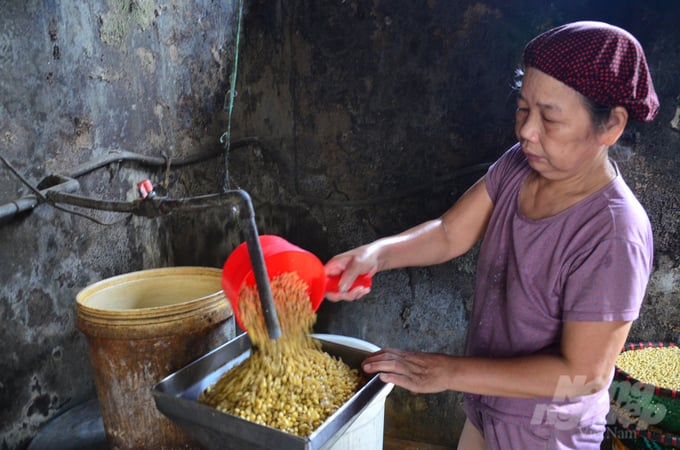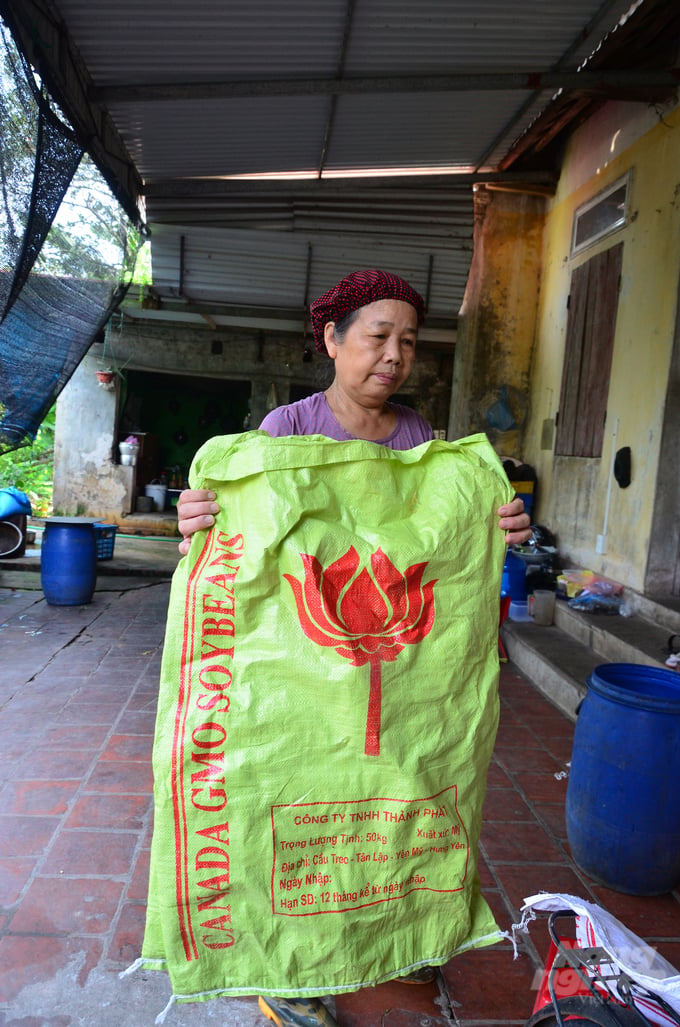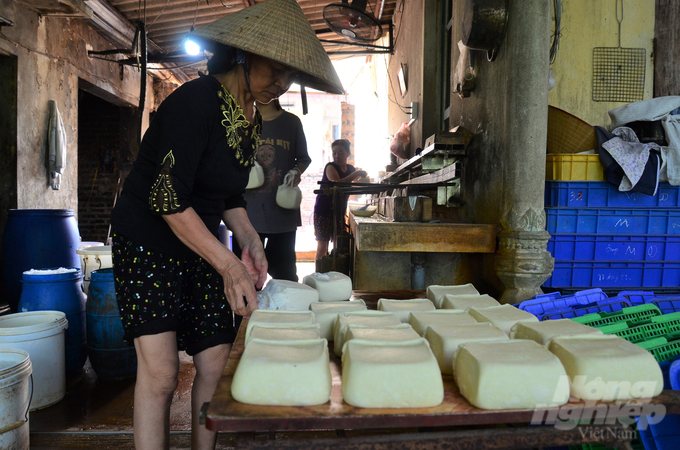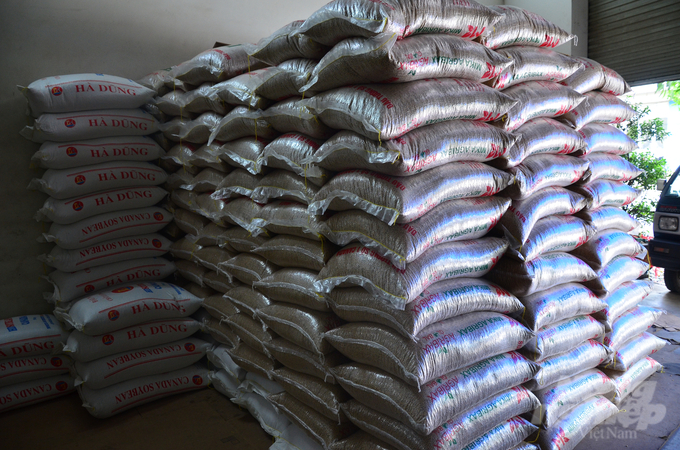May 30, 2025 | 09:49 GMT +7
May 30, 2025 | 09:49 GMT +7
Hotline: 0913.378.918
May 30, 2025 | 09:49 GMT +7
Hotline: 0913.378.918

Trinh Thi Binh by her batch of soaked beans. Photo: Duong Dinh Tuong.
At 8 am, when I arrived at Tra Lam village (Tri Qua commune, Thuan Thanh district, Bac Giang province), 62-year-old Trinh Thi Binh was busy driving around the village asking for help with a batch of soaked soybeans because she heard that there would be a power cut at 9. Normally, her factory closes the circuit breaker at 10 am, working until 3-4 pm. For steps such as machine grinding and squeezing, a power cut meant that the whole batch of soaked soybeans must be thrown away.
After two or three times of pouring "bean curd", compressing it again and again until it is even to the mouth of the mold, Tra Lam tofu is probably the largest tofu made in the country. 10 cm long, 5 cm wide, 10 cm high, each block weighs up to 600 -700 grams. Because of their slightly distorted shape, they are also called the “hunchback” tofu.
Making beans and raising pigs used to be a popular money-making formula for Tra Lam people to raise their children, help them go to school, pass exams, or go abroad. Stone mills have been replaced by grinders, coal ovens have been replaced by boilers, but the ancestor’s old craft is rapidly disappearing.
Just like in many other tofu craft villages, the income is only VND 150,000 - 200,000/work day, the work starts late at night until the day peak, so people simultaneously quit. From hundreds of households working on the craft, the burning ovens painting the village red, now only 20 households are still holding on.

Binh by the package of beans with the word “GMO” printed on it but no Vietnamese translation. The product is from Thanh Phat company, Hung Yen. Photo: Duong Dinh Tuong.
Binh's house is one of the largest workshops in the village. With 3 employees including her, her son and her sister-in-law, on average, they use 80-85 kg of soybean seeds per day to produce 250 - 270 blocks of tofu, each with a wholesale price of VND 9,000.
Asking about the present day’s soybeans, she looked in the corner of the house, pulled out a stack of packages and told me that she kept them to store rice in the harvest. There were several types of packages, in which the green one is printed with the words “GMO soybeans” but the term was not clearly stated in Vietnamese that it was genetically modified soybean. The packages were manufactured by Thanh Phat company in Yen My, Hung Yen.
“This one I used half a month ago. many years have passed since the day we had our native soybeans, now they are all imported from the United States and Canada. If it is to make tofu, Chinese soybeans are the best, but we can't handle the ‘heat’ because the price is much higher than US and Canadian beans, roughly VND 10,000/kg. People bring soybeans to offer, and I ‘scoop’ when I see it is a good deal, if it's bad, I pass. There is an agent in the village, Thoa Van, but they ‘squeeze’ y wallet dry, so I always take the stuff from outside as the current price is VND 18,000/kg”.

Binh's tofu workshop. Photo: Duong Dinh Tuong.
Like Binh, Nguyen Thi La chooses to make beans during the day, from 11 am to 5 pm, unlike most other establishments in Tra Lam village. The workshop has 3 workers including herself and 2 other employees. On average they use 45 kg of soybeans, and on a day when many customers order the amount used can be up to 60 - 70 kg. The focal point of consumption is the traders in the Dau market. Due to the high purchase price of soybeans, tofu sold at a cheap price, after a day of hard work, each person only got more than VND 100,000.

La holding the green pack with the word ”GMO” on the left. The product is of Thanh Phat company, Hung Yen. Photo: Duong Dinh Tuong.
“In the past, all soybeans were brought back from Cao Bang and Lang Son, since imported soybeans were present, people do not want to plant them anymore. Native soybeans are delicious, soft, flexible and easier to make tofu because they have a lot of sap, while American and Canadian soybeans are all dried, so they lose the sap, hence a drop in tofu’s quality.
“We don't have native soybeans anymore, so imported soybean it is. In the whole village, only Tai's family grow a few sao (Vietnamese measurement, equals 360 m2) of soybeans, producing more than 100 kg, but I don't know who he sold the land to. I don’t care if the packages are green, yellow, or white, the important thing is whether the seeds inside are good or bad. I usually buy from agents in Gia Binh district, Bac Ninh province, each time I get 500 - 700 kg”.

The bean packages of Phu Dat Company in Thai Binh are labeled “GMO” in Quyen's yard. Photo: Duong Dinh Tuong.
It was 11 am, but I still tried to call Nguyen Dinh Quyen to open the door because he was sleeping to make up for the night he was awake to work on the tofu blocks. In a drum containing a bunch of folded soybean packages, I noticed a light yellow package of Phu Dat Company in Thai Binh city with “GMO soybeans” written on it but absolutely saw no explanation in Vietnamese.
He leisurely said, “The goods were used a few months ago. Every day my family uses 30 kg of beans to make tofu, so we order 300 - 400 kg each time. The seller never said where the soybean came from. The tofu comes out clean, there's no mixing here that it needs to be checked for food hygiene and safety".

A corner of Thoa Van soybean shop. Photo: Duong Dinh Tuong.
After going halfway around Tra Lam village, I finally reached the Thoa Van shop, located right on the face of the road. Asking about the story of making tofu, Nguyen The Van, the shop owner, said that 10 years ago 70-80% of the villagers followed the craft, now only 10% were left. Therefore, from selling tens of tons of soybean every month, now the selling business is in a rough position.
The US soybeans are mainly sold as animal feed or crushed to water farmed crops, while Canadian soybeans are sold to make tofu. The price difference between the two types is VND 500 - 700/kg. When I showed him some pictures of soybean packages I just took in the village, he commented that most of them were of poor quality, the seller did not import directly, but got them from a warehouse somewhere.
Translated by Samuel Pham
/2025/05/25/4127-3-073637_820.jpg)
(VAN) Thanks to the promotion from an FAO-implemented project, vegetable production in greenhouses in Moc Chau has seen strong development, from 1.5 hectares in 2021 to nearly 50 hectares in 2024.

(VAN) FAO has recently supported USD 140,000 to implement the project 'Risk mitigation human-animal interface risks through disease control initiatives in pig farming.'

(VAN) The People's Committee of Tra Vinh province has approved an adjustment to the investment policy for the Green Hydrogen Plant project, increasing its area to approximately 52.76 hectares.
![Reducing emissions from rice fields: [2] Farmers’ commitment to the soil](https://t.ex-cdn.com/nongnghiepmoitruong.vn/608w/files/news/2025/05/05/dsc08881jpg-nongnghiep-140632.jpg)
(VAN) Clean rice cultivation model in Thuong Tan commune, Bac Tan Uyen district, is assisting local residents in achieving sustainable agriculture by substantially reducing costs, increasing productivity, and protecting the environment.

(VAN) At the conference to disseminate Resolution No. 68, AgriS introduced its digital agricultural ecosystem and reaffirmed its commitment to accompanying the Government in promoting private sector development and sustainable agriculture.

(VAN) 'Blue Ocean - Blue Foods' initiative is designed to restore marine ecosystems and establish sustainable livelihoods for local communities by cultivating a minimum of 1,000 hectares of cottonii seaweed in the first three years.
/2025/05/21/4642-3-112707_603.jpg)
(VAN) The V-SCOPE project has made direct contributions to three out of six pillars of the Comprehensive Strategic Partnership between Vietnam and Australia.